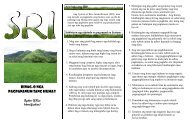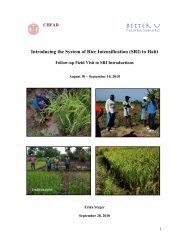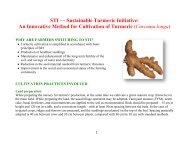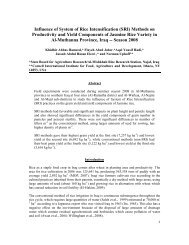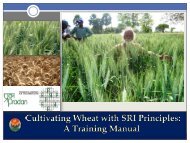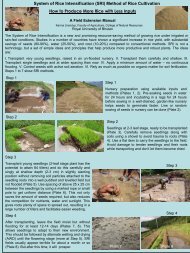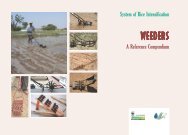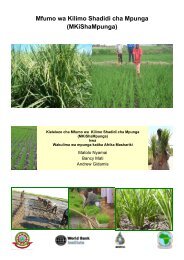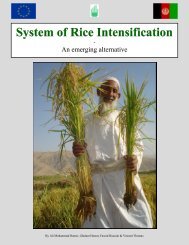EFFECT OF THE SYSTEM OF RICE INTENSIFICATION (SRI) ON ...
EFFECT OF THE SYSTEM OF RICE INTENSIFICATION (SRI) ON ...
EFFECT OF THE SYSTEM OF RICE INTENSIFICATION (SRI) ON ...
You also want an ePaper? Increase the reach of your titles
YUMPU automatically turns print PDFs into web optimized ePapers that Google loves.
Cambodia during modern times. In 1940 Cambodia was the third largest exporting country of rice<br />
in the world (Tong et al., 2007) and still during the 1960ies Cambodia was a leading partner in rice<br />
production in the world and continued to be so for many years (Koma, 2008) but civil wars later<br />
blocked any further development (Tong et al., 2007).<br />
Table 3. Average rice production, harvested area and<br />
rice yield in Cambodia from 1961 to 2006. Derived from IRRI (2006).<br />
Year Area (ha) Production (t) Yield (t/ha)<br />
1963 2.182.000 2.383.000 1.09<br />
2006 2.516.000 1 6.264.000 2.49<br />
1 According to Koma (2008) the total grown area in Cambodia with rice is app. 3.1 million ha with a<br />
potential of total agricultural production of app. 6.7 million ha.<br />
5.2 Rice cropping systems<br />
In Cambodia rice based farming systems often include lowland rice, dry season rice and early wet<br />
season rice (Mak, 2001), depending on location and access to water. The main rice cropping<br />
systems vary a lot especially regarding the water table. Figure 4 highlights the difference in water<br />
depth. The different rice cropping systems can be characterized as the following:<br />
• Upland rice or dryland rice: grown without water, normally related to areas with shifting<br />
cultivation (Greenland, 1997). Upland rice can often be intercropped with e.g. cassava, but<br />
often severe weed problems occur (De Datta, 1987).<br />
• Irrigated rice: The water table in the field can be controlled through the use of river/stream<br />
water and several rice crops are possible per year although sometimes drought is existing<br />
(Greenland, 1997).<br />
• Rainfed lowland rice: Dikes are build to catch both flood or rain water and the rice is often<br />
transplanted to the fields although also direct seeding sometimes dry or wet is existing (De<br />
Datta, 1987). Periods with drought can exist (Greenland, 1997).<br />
• Deepwater rice: 51 -100 cm water table normally grown in e.g. swampy areas in deltas (De<br />
Datta, 1987). Water regimes cannot be controlled and there are large risks of either drought<br />
damage or sudden flooding as seeds are sown on dry soil (De Datta, 1987).<br />
27



